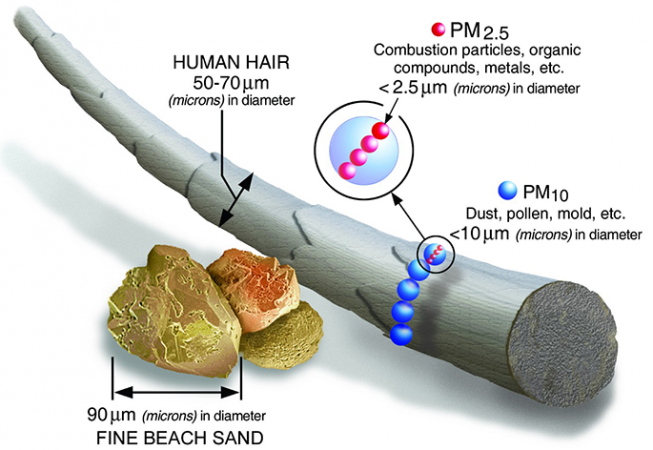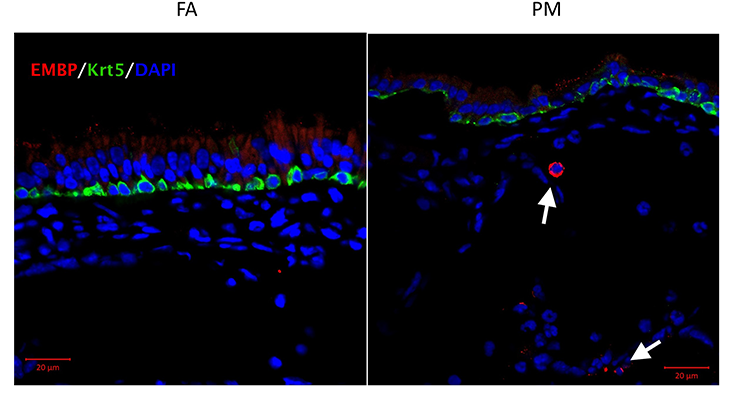Tiny air pollutants inflame airways and harm heart
New data from animals and people show how inhaled particles do their dirty work

Tiny bits of air pollution can cause chronic runny noses, blood-vessel changes and other problems, new studies show.
MYDinga/iStockphoto.com
Share this:
- Share via email (Opens in new window) Email
- Click to share on Facebook (Opens in new window) Facebook
- Click to share on X (Opens in new window) X
- Click to share on Pinterest (Opens in new window) Pinterest
- Click to share on Reddit (Opens in new window) Reddit
- Share to Google Classroom (Opens in new window) Google Classroom
- Click to print (Opens in new window) Print
If your nose runs year-round, air pollution could be part of the problem. A new study in mice shows how tiny airborne particles affect the nose and sinus areas. Those particles can also build up within fatty deposits in blood vessels, a second new study finds. Boosting these fatty build-ups could lead to more strokes and heart attacks. Together, these new data show that when inhaled, teeny particles can lead to big harm.

Particulates (Par-TIK-yu-lets) are a big category of small pollutants in the air. They include soot, smoke, dust, mists and other specks of material. Huge amounts come from burning coal, oil and wood. Particulates also spew from factories, farms and construction sites. The material is tiny — less than 10 micrometers (4 ten-thousandths of an inch) in diameter. Yet ongoing exposure to it raises the risk of lung disease, heart disease and other illnesses. Because of particulates, air pollution is the fourth leading cause of deaths worldwide, scientists reported last year.
Even when this pollution doesn’t kill, it can harm health, notes Murray Ramanathan. He’s a head and neck surgeon at Johns Hopkins University School of Medicine in Baltimore, Md. He and other scientists sometimes work with mice to learn more about what happens in human diseases of the nose, throat and sinuses. The animals are models that stand in for people.
In one of the new studies, Ramanathan’s team showed how particle pollution can cause or worsen chronic sinusitis (Sign-yu-SY-tis). Patients with this condition have stuffy and runny noses, facial pain behind the cheeks and other soreness. “Chronic” means that these symptoms last for 12 weeks or more.
More than 29 million people in the United States alone have the illness, reports the Centers for Disease Control and Prevention. This disease “has a huge impact on quality of life,” Ramanathan says. Patients have higher rates of depression than people who don’t have the disease. They miss more days of work. They’re also less productive and have lower well-being overall, he adds. Now his team has shown that pollution may be part of the problem.
Story continues below image.

Nosing around
For 16 weeks, the researchers exposed mice to particulates smaller than 2.5 micrometers. (That’s less than one ten-thousandth of an inch in diameter). The mice breathed this dirty air for six hours per day, five days each week. The time would be comparable to years of exposure in a person. The level of pollution was “probably about half of what we would see in India, or less,” Ramanathan says. India has some of the highest levels of air pollution in the world. So the mice experienced poor air quality, but not as bad as some people encounter in their daily lives. A control group of mice breathed only clean, filtered air.
At the end of the trial, the team rinsed the nose and sinus areas of each mouse with water. Then they examined the flushed-out water.
The rinse water from mice that had been breathing the polluted air showed that the inhaled particulates had triggered the immune systems in these rodents. For example, this water had an excess of macrophages (MAK-roh-fayj-es) — a type of white blood cells. These cells engulf and destroy foreign bodies, such as germs. Compared to the control group, the pollution-breathing mice had almost four times as many macrophages. Rinse water from these animals also had more proteins linked to inflammation. This inflammation is one way the body responds to injury. Its symptoms include swelling, heat and pain.
Story continues below image.

The researchers also looked at the nose and sinus tissues of these mice using a high-powered microscope. Tissues from the pollution-breathing mice showed signs of damage. It seemed like the particulates were “basically punching holes in the wall [of the sinuses],” Ramanathan says. That would make it easier for microbes and allergens to get through. (Allergens are things, such as pollen and pet dander, which can trigger allergies.)
The group’s work “adds to a growing list of ways that particles of air pollution have harmful effects around the body,” says Mark Miller. He’s a cardiovascular scientist at the University of Edinburgh in Scotland. He studies diseases of the heart and blood system.
Particulate levels in the United States are generally lower than those used in the study. Still, Ramanathan notes, exposure depends on location. A school playground near a busy highway, he points out, could have particulate levels two or three times higher than what is typical for a region.
The team published its new findings online February 28 in the American Journal of Respiratory Cell and Molecular Biology.
Chronic sinusitis isn’t life-threatening. But “it can be debilitating for those affected,” says Michael Brauer. He’s an epidemiologist (Ep-ih-dee-me-OL-oh-jizt) at the University of British Columbia in Vancouver, Canada. “We have quite strong evidence of effects of particulate matter on the lungs,” he says. “While not unexpected, this study provides evidence supporting effects on the sinuses.”
Into the blood
Inhaled particles don’t just cause breathing problems. They also increase risks for heart attacks, strokes and other diseases of the circulatory system. A new study shows how particles can move from the lungs into the heart and blood vessels to cause this harm.
Mark Miller’s team exposed people and mice to inhaled nanoparticles. Rather than have them breathe polluted outdoor air, the researchers exposed them to billionth-of-a-meter-size gold bits. These particles are “several thousand times smaller than the width of a human hair,” Miller explains. They are roughly the size of particles spewed in the exhaust of diesel engines.
Because gold does not react easily with other chemicals, it is “essentially harmless” to people, Miller explains. Yet special laboratory methods can easily detect where this faux pollution ends up within the body. Within a day of inhaling the nanoparticles, gold showed up in people’s blood and urine. And it was still there up to three months later! Gold also showed up in the mouse blood. But only the smallest nanoparticles made it into their urine.
Concludes Miller: “We showed that these tiny particles enter the blood and are carried around the body.” And the smaller the particles, the more likely they were to circulate in blood and end up in urine.
That’s not all. Some people in the study needed surgery (not for issues related to their taking part in the tests). These people had build-ups of certain fatty deposits, called plaque (PLAK), in the arteries that carry blood to the brain. When doctors removed some of that plaque, they found it contained gold bits. Gold also showed up in fatty plaques from mice that had similar build-ups. But the gold wasn’t present in tissue within healthy mouse arteries.
Fatty plaques are a sign of atherosclerosis (ATH-er-oh-skler-OH-sis). This disease contributes to heart attacks or strokes, Miller explains. Air pollution can make this plaque-based disease worse. Particles in air pollution carry harmful chemicals on their surface, he says — chemicals much more reactive than gold. If the tiny particles reach plaque, these pollutants might prompt the fatty deposits to break open. A heart attack or stroke could result. Miller’s team shared its findings April 26 in ACS Nano.
Many countries have laws meant to limit particulate pollution. It may seem that air in many places is getting cleaner. However, Miller notes, “levels of nanoparticles have been increasing with increasing amounts of [car and truck] traffic,” he says. And if the particles are especially small, they may not even be visible.
City air often contains up to 10,000 particles per cubic centimeter (or per 0.06 cubic inch). But, a team from Carnegie Mellon University in Pittsburgh showed that on days when the air appeared totally clear of pollution, up to 150,000 particles could pollute each cubic centimeter. The particulates were simply too small to affect visibility.
Adds Brauer: “We have more than enough evidence of the harmful effects of air pollution on human health.” And that “only increases the urgency to reduce air pollution exposure as a way to improve population health.”







